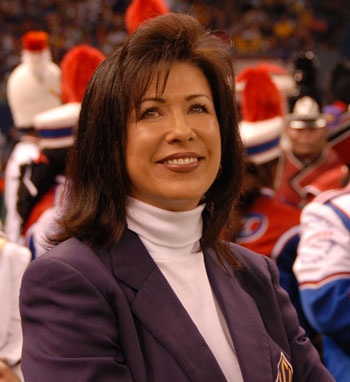Read additional comments from Dr. Linda Moorhouse, marching band co-director and associate director of bands for Louisiana State University, regarding motivation and the BCS National Championship experience. For the questions and answers that appeared in the printed article, click here.
Halftime: How do you motivate students?
Moorhouse: I do my best to count on the students’ own internal motivation. I also believe that the student leaders and upperclassmen set the rehearsal environment. If they’re ready to work, then the new members have no choice but to follow due to peer pressure. This goes back to student ownership in a program––students will take more interest to make something good if they feel they are a true part of the program.
We don’t see too many visiting college marching bands each season as we’re on the geographical edge of the Southeastern Conference, and we also don’t perform at high school marching exhibitions. Our motivation has to come from within.
Halftime: How would you describe your teaching style?
Moorhouse: As a teacher, I generally will know where all the traps and pitfalls will be in the program before we begin rehearsals, so I try to plan accordingly. I want to think I am a patient teacher who has high expectations––almost to a fault. Once I know my students can achieve a certain level, I won’t accept anything less.
Before, during and after rehearsals, I rely on my student leaders to help disseminate and collect information. There is a need to move quickly in Tiger Band practice as we rehearse four days a week—hour and a half rehearsals—and generally put multiple shows on the field each season. I like to infuse humor into rehearsals, and I do my best to instill a sense of confidence. It can be a daunting experience performing for over 93,000 people at one time in Tiger Stadium, or worse, in a torrential thunderstorm—we’re known to have a little rain here in Louisiana!
During rehearsals, I always try to explain what it is we are trying to improve upon as we rehearse specific sections in the music or drill or choreography. I have a very difficult time tolerating students who take advantage of other students or our expectations, rules or regulations.
Halftime: What are your goals for the band over the next couple of years?
Moorhouse: The LSU Tiger Band will continue to work to support, represent, and promote LSU and LSU athletics at the highest level as the University’s largest and most visible public relations vehicle.
We are also in the midst of a fundraising campaign for a much-needed new band hall. I hope we can be successful in this endeavor as our students work very hard in everything they are asked to do and deserve to be in a state-of-the-art building. The current band hall was built in 1959 for a band of about 150 members. It was too small the day it opened, and it is certainly too small for today’s 325 Tiger Band students.
Halftime: Is there anything else you would like to share about the BCS National Championship game?
Moorhouse: This game was a little different from the one four years ago in that this year, we had a nice lead going into the final minutes of the game. That makes for many minutes of happy, elated bandsmen. The students were enjoying the experience.
From what I understand, most of our TV coverage centered on what we did from our seats during the game. Many people in Baton Rouge, along with friends around the country who saw the game, told me how great the band looked. They especially loved all the horn visuals and choreography and said it looked like we were having great fun. We were!
I think our students love what we do in the stands as much as on the field. The section leaders work hard at the beginning of the season to teach all of the horn visuals and choreography not only to our school songs, but also to other tunes we have adopted as our own, like “Boogie Down,” “Neck” and “Hey, Baby.” We work so hard in rehearsal and on the field, it’s important to have fun during the game. I know our students do—and they especially did at the National Championship!
Halftime: Did the band’s performance at the game teach them or you anything new?
Moorhouse: No matter how much you prepare for something, a live performance is that—live. We will never perform a sequence exactly the same way as we did the last time. We’re not computers; we’re human, and one person can affect the music or a form.
The goal is to realize that each individual has to be accountable for every action and reaction. You have to be ready for the unexpected, especially in a highly pressurized environment. For the BCS National Championship game, we did our best to prepare the students, knowing they would not be able to hear themselves play at times because our fans—reacting to the band—would be so loud.
I’m sure it was an intimidating experience for many of our younger students, and I believe a few got caught up in the emotion of the moment.
Experience is always the best teacher. I know that many Tiger Band members want to do it all over again just to re-experience the hype!
Halftime: What advice would you give to marching band students?
Moorhouse: During my teaching career, I have found that some students who come from competitive marching programs or drum corps backgrounds have a difficult time adjusting to the college band experience. The objective of the college band is to promote school spirit and to entertain—not to win the next contest.
Photo by Sara Lynn Baird. All rights reserved.

